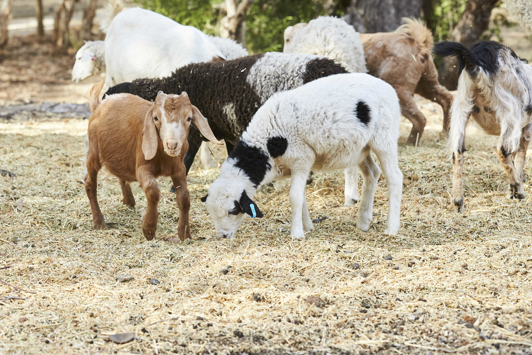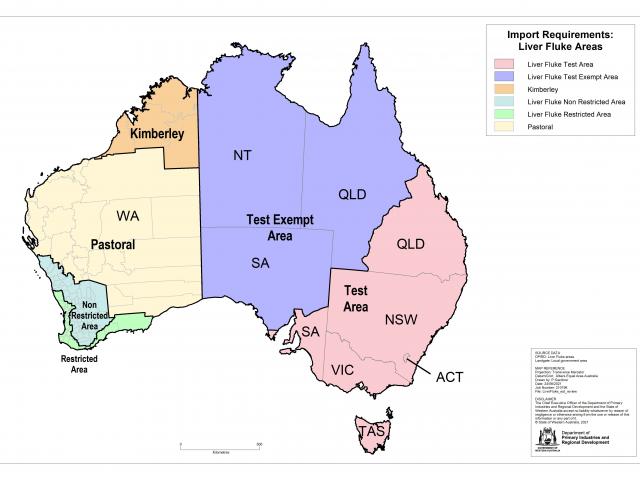The liver fluke conditions for importing horses into Western Australia changed on 1 December 2025. Read more about the new conditions.
Published import conditions apply to the following livestock imported into WA (whether they are kept as pets or for commercial purposes):
- equines (horses, ponies, mules, donkeys and any hybrids)
- cattle, bison, buffalo and hybrids
- deer
- sheep and goats
- camelids (camels and South American camelids such as alpaca and llama)
- pigs.
Import conditions are set out by the Biosecurity and Agriculture Management Act 2007 and the Biosecurity and Agriculture Management Regulations 2013.
Published import conditions and the LB1 health certificate for the movement of livestock into WA
All livestock being moved into WA must meet the published import requirements. The published import conditions take the form of species-specific LB1 health certificates for movement into WA. The pre-entry, entry and post-entry import requirements that must be met are detailed in part 3 of the health certificates.
Pre-entry and entry import requirements for livestock entering WA
To import livestock into WA, the pre-entry and entry import requirements detailed in part 3 of the health certificates must be met. A completed species-specific LB1 health certificate parts 1 and 2, and any supporting documentation (as detailed in part 3), should be emailed to the relevant Quarantine WA (QWA) entry inspection point a minimum of 3 days prior to the livestock arriving at the entry inspection point. The original signed health certificate and for cattle, sheep, goats and pigs, a National Vendor Declaration (NVD) must accompany the livestock at all times.
QWA actively protects WA’s biosecurity status by conducting inspections for quarantine risk material at entry inspection points for private travellers and commercial clients importing livestock from interstate.
QWA is responsible for inspecting all livestock imported into WA to ensure they meet the published import conditions. The entry inspection, along with any treatments and tests, washdown and entry certification will involve a fee, see Fees and charges information below.
Post-entry import requirements for livestock entering WA
Some diseases, such as liver fluke and footrot require treatment, testing or inspection post-entry. Imported livestock that require post-entry import conditions, as detailed in part 3 of the health certificates, will be issued an LB14 Inspector’s Direction Notice by a QWA Inspector at the entry inspection point, which outlines the post-entry import requirements for those imported livestock. This notice details the treatments, testing or inspections required and when they should be done.
The administration of the post-entry requirements must be undertaken by or under the direct supervision of a registered veterinary surgeon. The department's inspector is able to supervise the owner of the animal administering the post-entry requirements. Supervision of the treatment or faecal sample collection means that the person supervising is physically present at the time the activity occurs and ensures the correct animal is treated or sampled and that the correct dose is administered effectively.
The direction notice is issued to the owner of the animals and must be provided whenever control of the livestock changes to a new person. The department's District Office should also be notified of any change of ownership of livestock whilst the LB14 Inspector’s Direction Notice is in effect.
Until the post entry requirements listed on the LB14 Inspector’s Direction Notice are completed, livestock require a permit to move off the WA destination property. The permit to move can be applied for by contacting the department's District Office listed on the LB14 direction notice. The requirement to obtain a permit includes horses being moved from the nominated property for any reason, including to a trainer, vet, showground or racecourse.
The administration of the treatment and collection of the faecal sample must be done by or under the direct supervision of a registered veterinary surgeon. A DPIRD stock inspector (gazetted) can supervise the owner of the animal administering the treatments or collecting faecal samples. Supervision of the treatment or faecal sample collection means that the person supervising is physically present at the time the activity occurs and ensures the correct animal is treated or sampled and that the correct dose is administered effectively.
Approved laboratories and method
The laboratories listed below are approved by the department to test liver fluke samples, pre- and post-entry into WA as they:
- Participate in the department's liver fluke quality assurance scheme.
- Use the department's fluke egg sedimentation test (FEST) method or another approved method.
Please note that at present the Fasciola hepatica copro-antigen detection ELISA for post-entry samples from sheep and cattle is only approved if conducted by the department.
|
Contact name |
Laboratory address |
Phone |
|
Mr Cameron Loomes |
DPIRD Diagnostics and Laboratory |
|
|
Mrs Deanne Broughton |
Veterinary Pathology Laboratory |
08 9317 0777 |
|
Dr Grant Richards |
Para-Site Diagnostic Services |
03 5766 4374 |
|
Ms Maryke Du Plessis |
IDEXX Laboratories |
02 9898 7363 |
|
Ms Maria Hardy |
Elizabeth Macarthur Agricultural Institute Industry & Investment NSW |
02 4640 6315 |
|
Mr Hamish Southwood |
Gribbles Vet Pathology |
08 8202 3300 |
|
Ms Tania Rentsch |
Grampians Vet
|
03 5571 1202 |
|
Dr Natalie Leo |
Biosecurity Sciences Laboratory |
07 3708 8708 |
Download the department-approved fluke egg sedimentation test method below.
Footrot import conditions
Imported sheep are issued with a direction notice and require:
- inspection for footrot at 21 to 35 days and 90 to 100 days post-entry
- inspection by a registered veterinary surgeon or a gazetted DPIRD inspector.
Fees and charges
Biosecurity inspection fees and charges are payable by the importer, exporter or owner of the organism or potential carrier and by the owner or occupier of a property or facility. Fees apply for inspection, treatment, yarding, vehicle washdown and other activities related to importing livestock. Charges exist to maintain the quarantine inspection facilities at Kalgoorlie and Kununurra and enable year-round, on-call services at entry inspection points.
Traceability requirements for imported livestock
Under the Biosecurity and Agriculture Management (Identification and Movement of Stock and Apiaries) Regulations 2013, the owner of livestock must be registered with DPIRD to own livestock and have a property identification code (PIC). The livestock must also be identified by an approved method.
It is mandatory to record the movement of cattle, buffalo, sheep and goats to a property with a different PIC on the National Livestock Identification System (NLIS) database. The Biosecurity and Agriculture Management (Identification and Movement of Stock and Apiaries) Regulations 2013 require that the owner or receiver of the livestock transfer the livestock onto the receiving property PIC within 48 hours of the movement.
Visit the National Livestock Identification System (NLIS) database
Contact us
-
Livestock biosecurity


